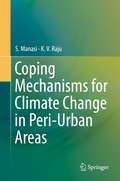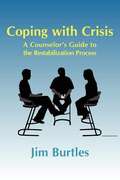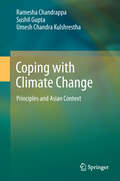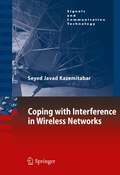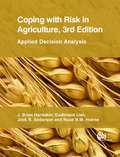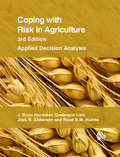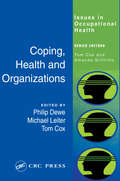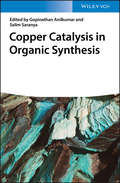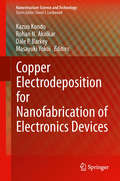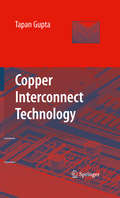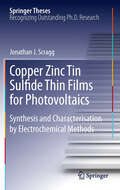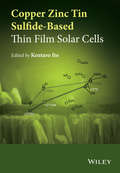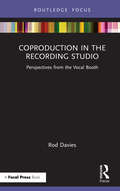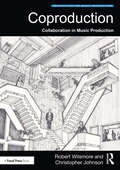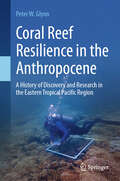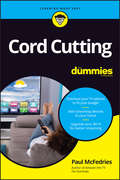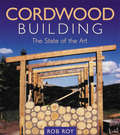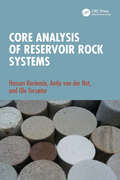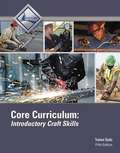- Table View
- List View
Coping Mechanisms for Climate Change in Peri-Urban Areas
by S. Manasi K. V. RajuThis book discusses the dynamics and resource management qualities of the peri-urban interface to address climate change consequences, focusing on the peri-urban region of the global city of Bengalaru. In 5 chapters, the authors document the unique challenges experienced in peri-urban areas, including soil-water vegetation dynamics, local and regional impacts on water bodies (surface and groundwater), food production issues, and the inhibited adaptive capacity of local communities. The book also provides knowledge on implementations of environmental management by local institutions, government interventions that have acted as catalysts in promoting community based adaptation strategies, and the physical, social and economic aspects of rural-urban dynamics. The book not only adds to the scarce existing literature on peri-urban contexts, but also addresses the role of culture in protecting ecological landscapes and how traditions play an important role in coping with climate change. Furthermore, the authors expand on these climate change coping mechanisms in peri-urban areas, taking into account local cultural factors and interesting governance interventions in the context of health. The book will be of interest to planners, policy makers, and students and researchers engaged in rural-urban dynamics and climate change adaptation.
Coping With Crisis: A Counselor's Guide to the Restabilization Process
by Jim BurtlesIn the wake of a catastrophic event, the witness may discover or experience unsettling emotions which can trigger subsequent behaviors. These reactions can lead to a number of consequences, some of which are unproductive.
Coping with COVID-19, the Mobile Way: Experience and Expertise from China
by Xiaoge XuThis edited book examines the impact of COVID-19 on selected areas of mobile studies, ranging from mobile public spaces to mobile workspaces. This book offers insights into how to leverage mobile devices, as well as features and communication to contain the pandemic. Specifically, it highlights the Chinese experience and lessons, and the country’s expertise in social capital management during the health crisis, governance of information flow and order, combating fake news and the infodemic, documenting the pandemic, and lessons learned from mobile health communication. It also discusses how small companies can survive the death of foreign trade during the pandemic. Looking beyond the pandemic, the book also explores the challenges and opportunities posed by the pandemic by investigating mobile learning, mobile journalism, mobile marketing and mobile workspaces. Given its scope, this book will enhance the global efforts in fighting the pandemic and contribute to the current body of knowledge on how to leverage mobile technologies to enhance public health communication during public health crises.
Coping with Climate Change: Principles And Asian Context
by Ramesha Chandrappa Sushil Gupta Umesh Chandra KulshresthaThe Environmental and climatic issues varies from continent to continent and is unique to Asia. Understanding the issues does need lot of research and study material which students may not be able to gather due to shortage of time and resources. Hence an effort is made by authors gathering there experience and academic input from renowned universities of world. Climate change is real and coping with it is major concern in coming days. Most of the books written and sold in the past need updating and customizing. The general description of climate change and world will not help the professionals and students. It needs to seen area wise as a professional will work in specific geographic area. Hence an effort is made to collect data from Asia which host most populated countries along with ecological hot spots.
Coping with Interference in Wireless Networks (Signals and Communication Technology)
by Seyed Javad KazemitabarUnlike wired networks where transmitters have no effect on receivers other than their own, in wireless networks we are limited by interference. The traditional routing methods are not optimal any more when it comes to a wireless medium. The maximum data rate on each link depends not only on the power in that link but also on the transmitted power from adjacent links. That is why the problem of power optimal routing needs to be solved jointly with scheduling. This suggests a cross layer design method as opposed to traditional networking where the algorithm for each layer is designed separately. In Coping with Interference in Wireless Networks we introduce several methods engaging different layers of network to mitigate interference in a wireless network.
Coping with Risk in Agriculture
by J Brian Hardaker Ruud B Huirne Gudbrand Lien Jock R AndersonRisk and uncertainty are inescapable factors in agriculture which require careful management. Farmers face production risks from the weather, crop and livestock performance, and pests and diseases, as well as institutional, personal and business risks. This revised third edition of the popular textbook includes updated chapters on theory and methods and contains a new chapter discussing the state-contingent approach to the analysis of production and the use of copulas to better model stochastic dependency. Aiming to introduce agricultural decision making, probability and risk preference, this book is an indispensable guide for students and researchers of agriculture and agribusiness management.
Coping with Risk in Agriculture: Applied Decision Analysis
by J Brian Hardaker Ruud B Huirne Gudbrand Lien Jock R AndersonRisk and uncertainty are inescapable factors in agriculture which require careful management. Farmers face production risks from the weather, crop and livestock performance, and pests and diseases, as well as institutional, personal and business risks. This revised third edition of the popular textbook includes updated chapters on theory and methods and contains a new chapter discussing the state-contingent approach to the analysis of production and the use of copulas to better model stochastic dependency. Aiming to introduce agricultural decision making, probability and risk preference, this book is an indispensable guide for students and researchers of agriculture and agribusiness management.
Coping, Health and Organizations
by Phil Dewe Tom Cox Michael LeiterThe consequences of ineffective coping are evident in the health of individuals and organisations. This book brings together a wealth of research and thinking about coping in occupational settings. Coping, Health and Organizations begins by looking at measurement of coping with stress. The theoretical and psychometric considerations discussed in
Copper Catalysis in Organic Synthesis
by Gopinathan Anilkumar Salim SaranyaThe most current information on growing field of copper catalysis Copper Catalysis in Organic Synthesis contains an up-to-date overview of the most important reactions in the presence of copper catalysts. The contributors—noted experts on the topic—provide an introduction to the field of copper catalysis, reviewing its development, scope, and limitations, as well as providing descriptions of various homo- and cross-coupling reactions. In addition, information is presented on copper-catalyzed C–H activation, amination, carbonylation, trifluoromethylation, cyanation, and click reactions. Comprehensive in scope, the book also describes microwave-assisted and multi-component transformations as well as copper-catalyzed reactions in green solvents and continuous flow reactors. The authors highlight the application of copper catalysis in asymmetric synthesis and total synthesis of natural products and heterocycles as well as nanocatalysis. This important book: Examines copper and its use in organic synthesis as a more cost-effective and sustainable for researchers in academia and industry Offers the first up-to-date book to explore copper as a first line catalyst for many organic reactions Presents the most significant developments in the area, including cross-coupling reactions, C–H activation, asymmetric synthesis, and total synthesis of natural products and heterocycles Contains over 20 contributions from leaders in the field Written for catalytic chemists, organic chemists, natural products chemists, pharmaceutical chemists, and chemists in industry, Copper Catalysis in Organic Synthesis offers a book on the growing field of copper catalysis, covering cross-coupling reactions, C–H activation, and applications in the total synthesis of natural products.
Copper Electrodeposition for Nanofabrication of Electronics Devices (Nanostructure Science and Technology #171)
by Kazuo Kondo Rohan N. Akolkar Dale P. Barkey Masayuki YokoiThis book discusses the scientific mechanism of copper electrodeposition and it's wide range of applications. The book will cover everything from the basic fundamentals to practical applications. In addition, the book will also cover important topics such as: * ULSI wiring material based upon copper nanowiring * Printed circuit boards * Stacked semiconductors * Through Silicon Via * Smooth copper foil for Lithium-Ion battery electrodes. This book is ideal for nanotechnologists, industry professionals, and practitioners.
Copper Interconnect Technology
by Tapan GuptaSince overall circuit performance has depended primarily on transistor properties, previous efforts to enhance circuit and system speed were focused on transistors as well. During the last decade, however, the parasitic resistance, capacitance, and inductance associated with interconnections began to influence circuit performance and will be the primary factors in the evolution of nanoscale ULSI technology. Because metallic conductivity and resistance to electromigration of bulk copper (Cu) are better than aluminum, use of copper and low-k materials is now prevalent in the international microelectronics industry. As the feature size of the Cu-lines forming interconnects is scaled, resistivity of the lines increases. At the same time electromigration and stress-induced voids due to increased current density become significant reliability issues. Although copper/low-k technology has become fairly mature, there is no single book available on the promise and challenges of these next-generation technologies. In this book, a leader in the field describes advanced laser systems with lower radiation wavelengths, photolithography materials, and mathematical modeling approaches to address the challenges of Cu-interconnect technology.
Copper Zinc Tin Sulfide Thin Films for Photovoltaics: Synthesis and Characterisation by Electrochemical Methods (Springer Theses)
by Jonathan J. ScraggJonathan Scragg documents his work on a very promising material suitable for use in solar cells. Copper Zinc Tin Sulfide (CZTS) is a low cost, earth-abundant material suitable for large scale deployment in photovoltaics. Jonathan pioneered and optimized a low cost route to this material involving electroplating of the three metals concerned, followed by rapid thermal processing (RTP) in sulfur vapour. His beautifully detailed RTP studies - combined with techniques such as XRD, EDX and Raman - reveal the complex relationships between composition, processing and photovoltaic performance. This exceptional thesis contributes to the development of clean, sustainable and alternative sources of energy
Copper Zinc Tin Sulfide-Based Thin Film Solar Cells
by Kentaro ItoBeginning with an overview and historical background of Copper Zinc Tin Sulphide (CZTS) technology, subsequent chapters cover properties of CZTS thin films, different preparation methods of CZTS thin films, a comparative study of CZTS and CIGS solar cell, computational approach, and future applications of CZTS thin film solar modules to both ground-mount and rooftop installation.The semiconducting compound (CZTS) is made up earth-abundant, low-cost and non-toxic elements, which make it an ideal candidate to replace Cu(In,Ga)Se2 (CIGS) and CdTe solar cells which face material scarcity and toxicity issues. The device performance of CZTS-based thin film solar cells has been steadily improving over the past 20 years, and they have now reached near commercial efficiency levels (10%). These achievements prove that CZTS-based solar cells have the potential to be used for large-scale deployment of photovoltaics.With contributions from leading researchers from academia and industry, many of these authors have contributed to the improvement of its efficiency, and have rich experience in preparing a variety of semiconducting thin films for solar cells.
Coproduction in the Recording Studio: Perspectives from the Vocal Booth
by Rod DaviesCoproduction in the Recording Studio: Perspectives from the Vocal Booth details how recording studio environments affect performance in the vocal booth. Drawing on interviews with professional session singers, this book considers sociocultural and sociotechnical theory, the modern home studio space, as well as isolation and self-recording in light of the COVID-19 pandemic. This is cutting-edge reading for advanced undergraduates, scholars and professionals working in the disciplines of recording studio production, vocal performance, audio engineering and music technology.
Coproduction: Collaboration in Music Production (Perspectives on Music Production)
by Christopher Johnson Robert WilsmoreCoproduction is dedicated specifically to the study of an emerging field in music production musicology. It explores the limits of what this field might be, from the workings of a few individuals producing music together in the studio, to vast contributions of whole societies producing popular music. Taking a wide-ranging approach to examining the field, Coproduction looks through multiple formats including essays, interviews, and case studies, with analysis and commentary of coproduction experiences at Abbey Road studios. It does so by examining multiple disciplines from social science and coproduction in mental health, to philosophy and mathematics. At its extremes (which is the extreme middle and not the blunt ‘cutting edge’) the authors attempt to produce every song in their development of an all-encompassing pop music concept, peculiarly called Toast theory. In attempting to unite the pragmatic collaborative patterns of Vera John-Steiner with philosophical postmodernist concepts of connection, Coproduction has something to offer readers interested in the traditional workings of teams of producers, as well as those seeking to understand the wider philosophy of collaboration in music production.
Copyright and Popular Media
by Trajce CvetkovskiCopyright governance is in a state of flux because the boundaries between legal and illegal consumption have blurred. Trajce Cvetkovski interrogates the disorganizational effects of piracy and emerging technologies on the political economy of copyright in popular music, film and gaming industries.
Coral Reef Remote Sensing: A Guide for Mapping, Monitoring and Management
by James A. Goodman Samuel J. Purkis Stuart R. PhinnRemote sensing stands as the defining technology in our ability to monitor coral reefs, as well as their biophysical properties and associated processes, at regional to global scales. With overwhelming evidence that much of Earth's reefs are in decline, our need for large-scale, repeatable assessments of reefs has never been so great. Fortunately, the last two decades have seen a rapid expansion in the ability for remote sensing to map and monitor the coral reef ecosystem, its overlying water column, and surrounding environment. Remote sensing is now a fundamental tool for the mapping, monitoring and management of coral reef ecosystems. Remote sensing offers repeatable, quantitative assessments of habitat and environmental characteristics over spatially extensive areas. As the multi-disciplinary field of coral reef remote sensing continues to mature, results demonstrate that the techniques and capabilities continue to improve. New developments allow reef assessments and mapping to be performed with higher accuracy, across greater spatial areas, and with greater temporal frequency. The increased level of information that remote sensing now makes available also allows more complex scientific questions to be addressed. As defined for this book, remote sensing includes the vast array of geospatial data collected from land, water, ship, airborne and satellite platforms. The book is organized by technology, including: visible and infrared sensing using photographic, multispectral and hyperspectral instruments; active sensing using light detection and ranging (LiDAR); acoustic sensing using ship, autonomous underwater vehicle (AUV) and in-water platforms; and thermal and radar instruments. Emphasis and Audience This book serves multiple roles. It offers an overview of the current state-of-the-art technologies for reef mapping, provides detailed technical information for coral reef remote sensing specialists, imparts insight on the scientific questions that can be tackled using this technology, and also includes a foundation for those new to reef remote sensing. The individual sections of the book include introductory overviews of four main types of remotely sensed data used to study coral reefs, followed by specific examples demonstrating practical applications of the different technologies being discussed. Guidelines for selecting the most appropriate sensor for particular applications are provided, including an overview of how to utilize remote sensing data as an effective tool in science and management. The text is richly illustrated with examples of each sensing technology applied to a range of scientific, monitoring and management questions in reefs around the world. As such, the book is broadly accessible to a general audience, as well as students, managers, remote sensing specialists and anyone else working with coral reef ecosystems.
Coral Reef Resilience in the Anthropocene: A History of Discovery and Research in the Eastern Tropical Pacific Region
by Peter W. GlynnThis book chronicles six decades of exploration and ecological studies of Western American coral reefs, a vibrant and diverse ecosystem in a marginal tropical Pacific region that has long been overlooked. It begins with the discovery of pristine coral reefs in Panama in the 1960s, follows the impact of stressful El Niño warming events that caused widespread coral bleaching and mortality in the 1980s-1990s, documents coral recovery in the late 1990s and early 2000s, and addresses the recent resurgence (2023-24) of extreme El Niño events leading to renewed coral mortality and setbacks in reef recovery. The book delves into the challenges posed by the physical environment, including recurring ENSO activity and increasing ocean acidification, and examines key ecological research topics such as coral reproduction, predation, bioerosion, symbioses, and biodiversity. It also highlights recent molecular genetic advancement in understanding coral endosymbionts, species identification, and phylogenetic relationships. Along the way, personal anecdotes from the eastern Pacific coral research team – ranging from exhilarating to amusing, frightening, and occasionally embarrassing – are shared throughout this scientific journey. This narrative offers a glimpse into the community composition of species and their interactions before severe bleaching and widespread coral mortality, information that is necessary to help guide restoration work. Sketches of coral reef animal associates by Peter W. Glynn and the late Charles Messing add an artistic dimension, highlighting the ecological roles of various species within the reef ecosystem. Many students have made significant contributions to the understanding and conservation of eastern Pacific coral reefs, with several going on to pursue careers in academia, research, and restoration, emerging as the next generation of reef scientists. The book concludes with a cautiously optimistic hope that humanity will shift away from reliance on fossil fuels, and that Generation Z (and their future students) will discover ways to restore coral reefs for future generations.
Coral Reefs and Associated Marine Fauna around the Arabian Peninsula
by Najeeb M.A. Rasul Ian C.F. StewartCoral Reefs and Associated Marine Fauna around the Arabian Peninsula is a unique text that contains studies on a diverse range of topics related to the biology of the Red Sea and Arabian (Persian) Gulf region.Containing invited and peer-reviewed chapters, this book is a compilation of the works of various experts in their respective fields. The authors delve into the marine fauna around the Arabian Peninsula, including marine reptiles and mammals, coral reefs, fish, invertebrates, algae and phytoplankton. They also explore the changes resulting from anthropogenic and climate effects.This book will be a helpful resource for researchers in Biology and will also be a valuable reference for anyone interested in the biology of these two warm semi-isolated seas with their unique environments.
Cord Cutting For Dummies
by Paul McFedriesCut the cable television cord and cut your monthly bills Are you one of those people who have 500 television channels to choose from and you can never find anything to watch? Maybe it’s time to cut the cable cord and take full control of what’s on your television. All you need to get started with this popular money saving strategy is an Internet connection, a device to stream to, and the advice in this book. With Cord Cutting For Dummies, you go from evaluating if cord cutting is the right choice for your budget to acquiring the technology to get the programming you actually want. You’ll discover the technology you need for streaming, select the service or services that fit your needs, and make the components of your setup work together—all within your budget. Cord Cutting For Dummies offers the steps to going from wired to wireless, including: Deciding if you need to upgrade your Wi-Fi equipment and service. Evaluating your current devices. Adding a smart TV to the mix. Choosing the best streaming services for you—including some free options When you’re ready to untether yourself from the cable or satellite, Cord Cutting For Dummies shows you, step by step, how to break free. Pick up a copy and you’ll be watching your favorite movie or TV show in no time!
Cordwood Building
by Rob RoyCordwood masonry is an ancient building technique whereby walls are constructed from "log ends" laid transversely in the wall. It is easy, economical, aesthetically striking, energy-efficient, and environmentally sound.Cordwood Building collects the wisdom of more than 25 of the world's best practitioners, detailing the long history of the method, and demonstrating how to build a cordwood home using the latest and most up-to-date techniques, with a special focus on building code issues.Author/editor Rob Roy has been building, researching, and teaching about cordwood masonry for 25 years and, with his wife, started Earthwood Building School in 1981. He has written 10 books on alternative building, presented four videos--including two about cordwood masonry--and has taught cordwood masonry all over the world.
Core Analysis of Reservoir Rock Systems
by Hassan Karimaie Antje van der Net Ole TorsæterCore analysis is an essential source of quantitative data on reservoir properties. These data are used for modeling the distribution and flow of oil and gas reservoirs, CO2 and hydrogen storage, and flow behavior in geothermal reservoirs. While several books cover core analysis for practitioners, this book fills a gap through introducing laboratory equipment and procedures used in core analysis and the theoretical aspects of the parameters. It offers detailed instructions on experimental execution for those with limited or no experience including risk analysis for high safety. Emphasizes the basic characterization of porous materials for multiphase flow, specifically consolidated natural materials Features methods commonly used in the special core analysis within the oil and gas industry, extending to the emerging field of gas storage with occasional references to research-oriented equipment Offers detailed descriptions of laboratory exercises and instructions on data analysis suitable for student work Includes solutions to some exercises to demonstrate the application of measured parameters in reservoir evaluation Provides a unique combination of brief discussions on the basic theory of parameters, explanations of experimental principles, detailed experimental procedures according laboratory standards, and data analysis, with multiple laboratory-related example problems This concise and practical workbook is written for everyone interested in practical measurements of parameters needed for analysis of fluid flow in porous media, specifically students, or for starting staff in the laboratory, preferably with a background in geosciences or fluid mechanics or related topics.
Core Concepts and Methods in Load Forecasting: With Applications in Distribution Networks
by William Holderbaum Stephen Haben Marcus VossThis comprehensive open access book enables readers to discover the essential techniques for load forecasting in electricity networks, particularly for active distribution networks.From statistical methods to deep learning and probabilistic approaches, the book covers a wide range of techniques and includes real-world applications and a worked examples using actual electricity data (including an example implemented through shared code). Advanced topics for further research are also included, as well as a detailed appendix on where to find data and additional reading. As the smart grid and low carbon economy continue to evolve, the proper development of forecasting methods is vital. This book is a must-read for students, industry professionals, and anyone interested in forecasting for smart control applications, demand-side response, energy markets, and renewable utilization.
Core Curriculum: Introductory Craft Skills
by National Center for Construction Education ResearchThis exceptionally produced trainee guide features a highly illustrated design, technical hints and tips from industry experts, review questions and a whole lot more! Nine modules in all provides coverage of: Basic Safety, Introduction to Construction Math, Introduction to Hand Tools, Introduction to Power Tools, Construction Drawings, Basic Rigging, Basic Communication Skills, Basic Employability Skills, and Introduction to Materials Handling.
Core Curriculum: Introductory Craft Skills Trainee Guide (Fifth Edition)
by Nccer<p>Welcome to the world of construction! Construction is one of the largest industries, offering excellent opportunities for high earnings, career advancement, and business ownership. <p>Work in construction offers a great variety of career opportunities. People with many different talents and educational backgrounds--skilled craftspersons, managers, supervisors, and superintendents--find job opportunities in construction and related fields. As you will learn throughout your training, many other industries depend upon the work you will do in construction. From houses and office buildings to factories, roads, and bridges--everything begins with construction. <p>This exceptionally produced trainee guide features: Basic Safety, Introduction to Construction Math, Introduction to Hand Tools, Introduction to Power Tools, Introduction to Blueprints, Basic Rigging, Basic Communication Skills, Employability Skills, and more.</p>
